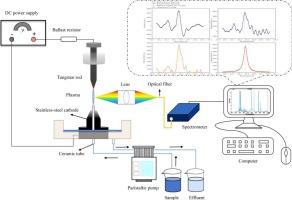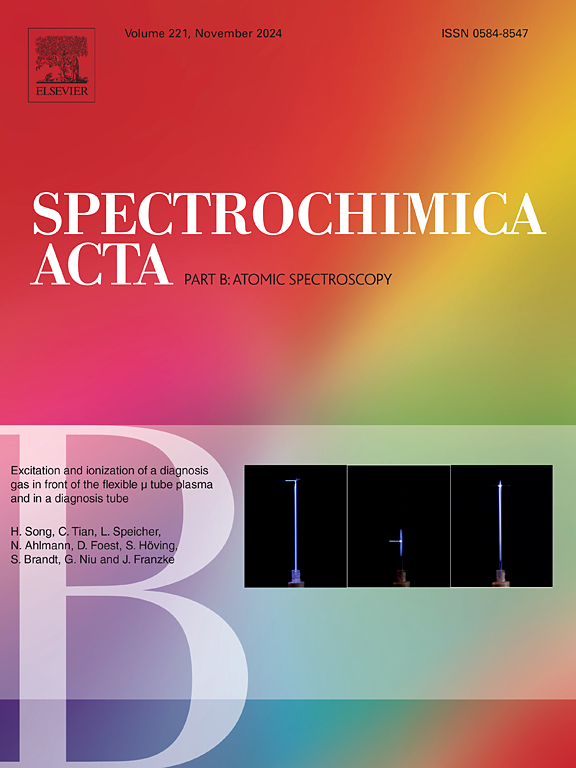基于拟合精度的迭代位移差分算法对溶液阴极辉光放电(SCGD)原子发射光谱(AES)的基线校正
IF 3.8
2区 化学
Q1 SPECTROSCOPY
引用次数: 0
摘要
溶液阴极辉光放电原子发射光谱(SCGD-AES)是一种检测痕量金属元素的优良分析技术,但其定量分析的准确性受到光谱干扰和连续介质背景的严重影响。本文提出了一种基于迭代移差的算法来同时校正这些干扰效应和连续背景。该方法对光谱进行波长移位,从原始未移位的光谱中减去移位的光谱,以最小化背景波动,然后使用反褶积恢复光谱轮廓。此外,引入了基于校准曲线拟合精度的迭代位移步进优化,以适应元素间的光谱差异。该方法应用于连续背景和光谱干扰下水溶液样品中Zn、Fe、Mg、Cu和Ca的SCGD-AES分析。实验结果表明,ISDF算法消除了重复空白背景测量的需要。对Zn、Fe、Mg、Cu和Ca的校准曲线拟合精度(R2)均超过0.995,测量误差减小至约5%。这些指标超越了矩阵匹配校准、移动平均切角(MA-CC),达到了与相邻光谱背景相减(adjacant -background)相当的效果。结果表明,该算法可提高存在光谱干扰的SCGD-AES定量分析的准确性。本文章由计算机程序翻译,如有差异,请以英文原文为准。

Baseline correction for solution cathode glow discharge (SCGD) atomic emission spectroscopy (AES) using an iterative shift difference algorithm based on fitting-accuracy
Solution cathode glow discharge atomic emission spectroscopy (SCGD-AES) is an excellent analytical technique for detecting trace metal elements, yet its quantitative analysis accuracy is severely affected by spectral interference and continuum background. Here, an algorithm based on iterative shift difference was proposed for simultaneous correction of these interference effects and continuum background. The method applies a wavelength shift to the spectrum, subtracts the shifted spectrum from the original unshifted one to minimize background fluctuations, and subsequently restores the spectral profile using a deconvolution. Additionally, iterative shift step optimization based on calibration curve fitting-accuracy is introduced to accommodate spectral differences across elements. This method was applied for SCGD-AES analyses of Zn, Fe, Mg, Cu and Ca with continuum backgrounds and spectral interference in aqueous solution samples. Experimental results demonstrate that the ISDF algorithm eliminates the need for repeated blank background measurements. It achieves a fitting accuracy (R2) for calibration curves exceeding 0.995 for Zn, Fe, Mg, Cu and Ca and reduces measurement errors to approximately 5 %. These metrics surpass those of matrix-matched calibration, moving-average corner-cutting (MA-CC), and achieves equivalent effect to the subtraction of adjacent spectral background (adjacent-background). The results demonstrated that the developed algorithm contributed to accuracy improvement for SCGD-AES quantitative analyses with the presence of spectral interference.
求助全文
通过发布文献求助,成功后即可免费获取论文全文。
去求助
来源期刊
CiteScore
6.10
自引率
12.10%
发文量
173
审稿时长
81 days
期刊介绍:
Spectrochimica Acta Part B: Atomic Spectroscopy, is intended for the rapid publication of both original work and reviews in the following fields:
Atomic Emission (AES), Atomic Absorption (AAS) and Atomic Fluorescence (AFS) spectroscopy;
Mass Spectrometry (MS) for inorganic analysis covering Spark Source (SS-MS), Inductively Coupled Plasma (ICP-MS), Glow Discharge (GD-MS), and Secondary Ion Mass Spectrometry (SIMS).
Laser induced atomic spectroscopy for inorganic analysis, including non-linear optical laser spectroscopy, covering Laser Enhanced Ionization (LEI), Laser Induced Fluorescence (LIF), Resonance Ionization Spectroscopy (RIS) and Resonance Ionization Mass Spectrometry (RIMS); Laser Induced Breakdown Spectroscopy (LIBS); Cavity Ringdown Spectroscopy (CRDS), Laser Ablation Inductively Coupled Plasma Atomic Emission Spectroscopy (LA-ICP-AES) and Laser Ablation Inductively Coupled Plasma Mass Spectrometry (LA-ICP-MS).
X-ray spectrometry, X-ray Optics and Microanalysis, including X-ray fluorescence spectrometry (XRF) and related techniques, in particular Total-reflection X-ray Fluorescence Spectrometry (TXRF), and Synchrotron Radiation-excited Total reflection XRF (SR-TXRF).
Manuscripts dealing with (i) fundamentals, (ii) methodology development, (iii)instrumentation, and (iv) applications, can be submitted for publication.

 求助内容:
求助内容: 应助结果提醒方式:
应助结果提醒方式:


